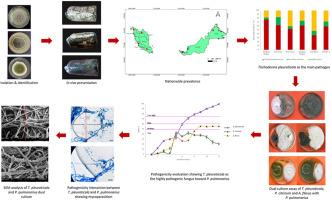真菌在混合:解开胸膜木霉,黄曲霉和柠檬青霉在马来西亚的肺侧耳菌栽培的致病性
IF 3.8
Q2 BIOTECHNOLOGY & APPLIED MICROBIOLOGY
引用次数: 0
摘要
在马来西亚和其他国家,肺平菇(Pleurotus pulmonarius,俗称灰平菇)种植袋上的真菌感染给蘑菇种植者造成了巨大损失。以前的研究已经能够分离出致病的真菌病原体。然而,这些工作大多集中在分离病原体;它们对肺假单胞菌的毒力尚不清楚。因此,本研究旨在分离、表征和评估在肺双歧杆菌双重培养试验中发现的物种的侵袭性。此外,我们的目的是描绘每个物种的区域分布,并评估其对肺假单胞菌的侵袭性。成功分离出三种真菌,分别为胸膜木霉、黄曲霉和柑橘青霉。在大多数采样地点,胸膜蝗是最常见的物种。在与病原菌一起培养的双重培养实验中,只有胸膜菌和黄芽孢杆菌的菌丝生长速率(mgr)显著增加。胸膜菌的损害更为明显,因为病原菌也同时抑制了蘑菇的MGR。耐药性分析表明,除对胸膜弓形菌感染完全丧失耐药性外,对肺假单胞菌的定植和破坏率为100%。显微分析表明,胸膜菌通过盘绕、包裹和裂解肺芽孢杆菌的菌丝系统来竞争空间和真菌寄生。附着胞样结构的形成介导菌丝穿透也很明显。这些病原体在体内袋中单独生长时会产生独特的图案,这有助于根据感染袋上呈现的图案来评估治疗的价值。这项研究的发现可以加强对疾病如何发展到严重程度的理解,从而帮助种植者更好地评估疾病的严重程度,以确保其治疗的可行性。本文章由计算机程序翻译,如有差异,请以英文原文为准。

Fungi in the mix: Unravelling the pathogenicity of Trichoderma pleuroticola, Aspergillus flavus, and Penicillium citrinum in Pleurotus pulmonarius cultivation in Malaysia
Fungal infections on grow bags of Pleurotus pulmonarius, which is more widely known as grey oyster mushroom, have caused massive losses to mushroom growers in Malaysia and other countries. Previous studies have been able to isolate the causative fungal pathogens. Nevertheless, most of these works have mainly focused on isolating the pathogens; their virulence toward P. pulmonarius is less understood. Thus, the present study aimed to isolate, characterize, and evaluate the aggressiveness of the species found in a dual culture assay with P. pulmonarius. Furthermore, we aim to delineate the distribution of each species regionally and evaluate their aggressiveness toward P. pulmonarius. Three fungal species were successfully isolated, namely, Trichoderma pleuroticola, Aspergillus flavus, and Penicillium citrinum. T. pleuroticola was the most prevalent species in most sampled locations. In a dual culture assay where the mushroom was grown with the pathogens, only T. pleuroticola and A. flavus presented a significant increase in their mycelial growth rates (MGRs). The damages were more pronounced with T. pleuroticola, as the pathogen also concomitantly suppressed the MGR of the mushroom. Resistance analysis demonstrated 100 % colonization and damages toward P. pulmonarius, besides the complete loss of resistance toward T. pleuroticola infection. Microscopic analysis revealed a competition for space and mycoparasitism, as T. pleuroticola competed by coiling, wrapping, and lysing the hyphal system of P. pulmonarius. The formation of appressoria-like structures that mediated hyphal penetration was also evident. These pathogens produced a distinctive pattern when grown singly in in vivo bags, which could aid in evaluating the worthiness of treatment on the basis of the pattern presented on the infected bag. The findings of this study could enhance the understanding of how disease presentation can progress to severe, thus, helping growers to better assess the severity of the disease to ensure its viability for treatment.
求助全文
通过发布文献求助,成功后即可免费获取论文全文。
去求助
来源期刊

Biocatalysis and agricultural biotechnology
Agricultural and Biological Sciences-Agronomy and Crop Science
CiteScore
7.70
自引率
2.50%
发文量
308
审稿时长
48 days
期刊介绍:
Biocatalysis and Agricultural Biotechnology is the official journal of the International Society of Biocatalysis and Agricultural Biotechnology (ISBAB). The journal publishes high quality articles especially in the science and technology of biocatalysis, bioprocesses, agricultural biotechnology, biomedical biotechnology, and, if appropriate, from other related areas of biotechnology. The journal will publish peer-reviewed basic and applied research papers, authoritative reviews, and feature articles. The scope of the journal encompasses the research, industrial, and commercial aspects of biotechnology, including the areas of: biocatalysis; bioprocesses; food and agriculture; genetic engineering; molecular biology; healthcare and pharmaceuticals; biofuels; genomics; nanotechnology; environment and biodiversity; and bioremediation.
 求助内容:
求助内容: 应助结果提醒方式:
应助结果提醒方式:


